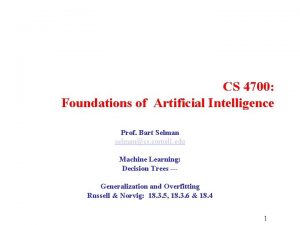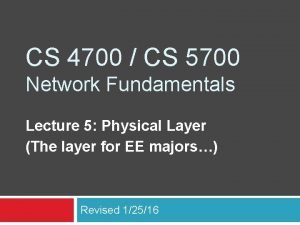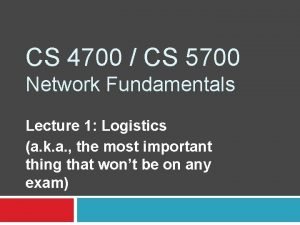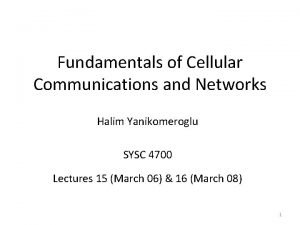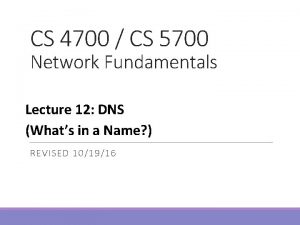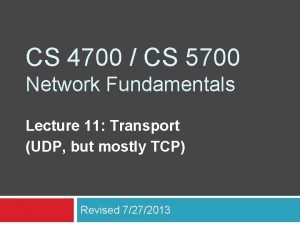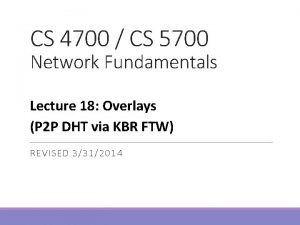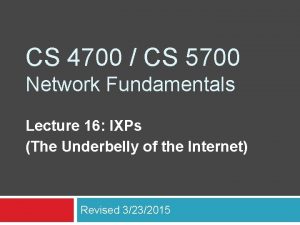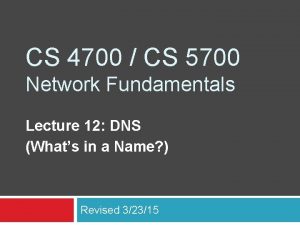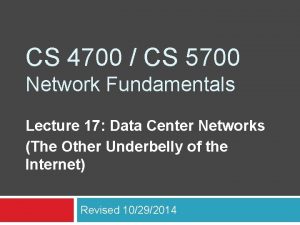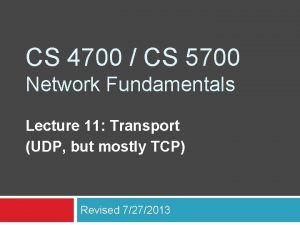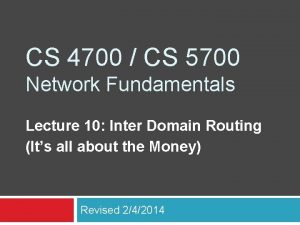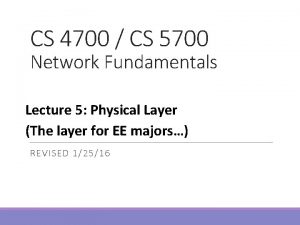CS 4700 CS 5700 Network Fundamentals LECT URE


























- Slides: 26

CS 4700 / CS 5700 Network Fundamentals LECT URE 2: H ISTOR Y (H INT : AL G ORE *D ID* HAVE A S MALL ROLE ) REVISED 1/10/16

What is a Communication Network? A communications network is a network of links and nodes arranged so that messages may be passed from one part of the network to another What are nodes and links? Networks are key for: ◦ People and roads Speed ◦ Telephones • and switches ◦ Computers • and routers Distance What is a message? ◦ Information 2

Networks are Fundamental Smoke Signals! 3

Networks are Old 2400 BC: courier networks in Egypt 550 BC: postal service invented in Persia Problems: • Speed • Reliability • Security 4

Towards Electric Communication 1837: Telegraph invented by Samuel Morse ◦ Distance: 10 miles ◦ Speed: 10 words per minute ◦ In use until 1985! Higher compression = faster speeds Key challenge: how to encode information? ◦ Originally used unary encoding A • B • • C • • • D • • E • • • ◦ Next generation: binary encoding A • – B – • • • C – • D – • • E • 5

Telephony 1876 – Alexander Graham Bell invents the telephone Key challenge: how to scale the network? Advantages ◦ Originally, all phones were directly connected • §Easy to use O(n ) complexity; n*(n– 1)/2 Switching • ◦ 1878: Switching mitigates complexity ◦ 1937: Trunk lines + multiplexing • Makes cable management tractable Problems • Manual switching • 1918: cross country call took 15 minutes to set up 2 6

Growth of the Telephone Network 1881: Twisted pair for local loops 1885: AT&T formed 1892: Automatic telephone switches 1903: 3 million telephones in the US 1915: First transcontinental cable 1927: First transatlantic cable 1937: first round-the-world call 1946: National numbering plan 7

Evolution of switching Telephone networks are circuit switched ◦ Each call reserves resources end-to-end ◦ Provides excellent quality of service Problems ◦ Resource intense (what if the circuit is idle? ) ◦ Complex network components (per circuit state, security) Packet switching ◦ No connection state, network is store-and-forward ◦ Minimal network assumptions ◦ Statistical multiplexing gives high overall utilization 8

The World’s Most Successful Computer Science Research Project 9

History of the Internet 1961: Kleinrock @ MIT: packet-switched network 1962: Licklider’s vision of Galactic Network 1965: Roberts connects computers over phone line 1967: Roberts publishes vision of ARPANET 1969: BBN installs first Interface. Msg. Processor at UCLA 1970: Network Control Protocol (NCP) 1972: Public demonstration of ARPANET 1972: Kahn @ DARPA advocates Open Architecture 1972: Vint Cerf @ Stanford writes TCP 10

The Internet, Explained by Vint Cerf on Colbert Report (Part 1) 11

The 1960 s 13

1971 14

1973 15

More from Vint Cerf on Colbert Report (Part 2) 16

Growing Pains Problem: early networks used incompatible protocols 17

Kahn’s Ground Rules 1. Each network is independent, cannot be forced to change 2. Best-effort communication (i. e. no guarantees) 3. Routers connect networks 4. No global control Principles behind the development of IP Led to the Internet as we know it Internet is still structured as independent networks 18

The Birth of Routing Trivia • Kahn believed that there would only be ~20 networks. • He was way off. • Why? 19

Internet Applications Over Time 1972: Email 1973: Telnet – remote access to computing 1982: DNS – “phonebook” of the Internet 1985: FTP – remote file access 1989: NFS – remote file systems 1991: The World Wide Web (WWW) goes public 1995: SSH – secure remote shell access 1995 -1997: Instant messaging (ICQ, AIM) 1998: Google 1999: Napster, birth of P 2 P 2001: Bittorrent 2004: Facebook Invented by Shawn 2005: You. Tube 2006: Twitter Fanning at NEU 2007: The i. Phone 2016+: Io. T, Oculus Rift, …? What is next? 20

2000 21

2006 22

2009 23

2010 24 24

More Internet History 1974: Cerf and Kahn paper on TCP (IP kept separate) 1980: TCP/IP adopted as defense standard 1983: ARPANET and MILNET split 1983: Global NCP to TCP/IP flag day 198 x: Internet melts down due to congestion 1986: Van Jacobson saves the Internet (BSD TCP) 1987: NSFNET merges with other networks 1988: Deering and Cheriton propose multicast 199 x: Qo. S rises and falls, ATM rises and falls 1994: NSF backbone dismantled, private backbone 1999 -present: The Internet boom and bust … and boom 2007: Release of i. Phone, rise of Mobile Internet 201 x-present: Rise of software-defined networks, smart homes 25

Enough about history This is not a history course The Internet is constantly evolving I will teach you about ◦ The principles on which it was founded ◦ The fundamental protocols that drive it ◦ The various applications built atop it ◦ How these networks are deployed today ◦ Future directions it might go 26

Takeaways Communication is fundamental to human nature Key concepts have existed for a long time ◦ Speed/bandwidth ◦ Latency ◦ Switching ◦ Packets vs. circuits o o Encoding Cable management Multiplexing Routing The Internet has changed the world ◦ Promise of free ($) and free (freedom) communication ◦ Shrunk the world What made the Internet so successful? Stay tuned! 27
 Var lect
Var lect In 5700 significant digit are
In 5700 significant digit are Kp va gold 0/20/vision
Kp va gold 0/20/vision Cs 4700
Cs 4700 Cs 4700
Cs 4700 Cs 4700
Cs 4700 Cs 4700
Cs 4700 A trader mixes 26 kg of rice
A trader mixes 26 kg of rice Opnavnote 4700
Opnavnote 4700 Sysc 4700
Sysc 4700 When a hero falls
When a hero falls Folk epic definition
Folk epic definition Oksidatif deaminasyona uğrayan aminoasitler
Oksidatif deaminasyona uğrayan aminoasitler Olde english examples
Olde english examples Puma deviate
Puma deviate Ornitin döngüsü enzimleri
Ornitin döngüsü enzimleri üre sentezi nerede olur
üre sentezi nerede olur Sončna ura izdelava
Sončna ura izdelava Galactic phonics ure
Galactic phonics ure Biotinidaz eksikliği
Biotinidaz eksikliği üre döngüsü
üre döngüsü Upravna enota tobačna
Upravna enota tobačna Nataša gorjup
Nataša gorjup Fæder ure þu þe eart on heofonum
Fæder ure þu þe eart on heofonum Une ure
Une ure Faeder ure
Faeder ure Ure words
Ure words



